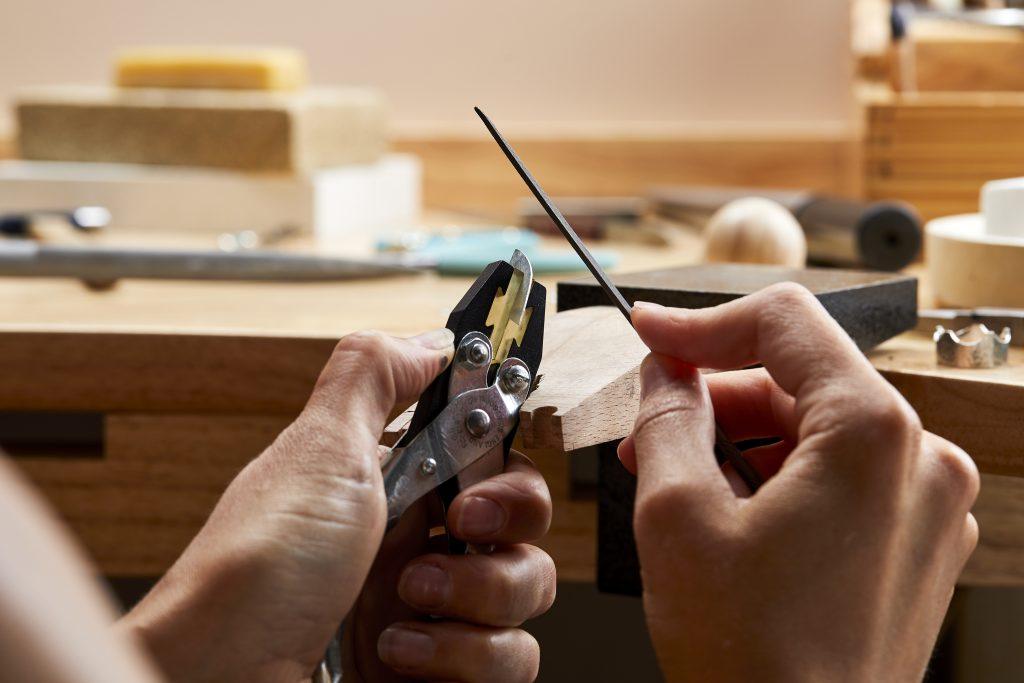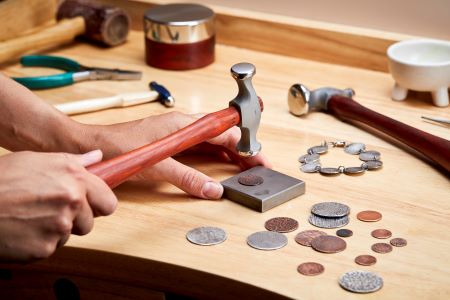A Guide to Exploring Texturing Techniques in Jewellery Making
Adding texture to metal is a fantastic way to enhance your jewellery designs, giving them depth and character. Texturing involves altering the surface of the metal to create visual interest and can range from different finishes to bold, striking patterns. Different techniques allow for a variety of effects and this guide will help you decide on the best one to use with your jewellery.
Texture can be achieved through physical manipulation, such as hammering, stamping or file texturing. Some methods create uniform textures, while others produce unique effects. Below are some popular texturing methods, how to achieve them and what they’re best suited for.
Stamping
Stamping is one of the most accessible and versatile ways to add texture. Using metal stamps with different designs, like floral patterns or initials, you can press an imprint directly onto your piece. The key to successful stamping is using a firm surface, such as a steel bench block and striking the stamp with a heavy mallet or hammer to ensure a clean, even impression.

This technique is excellent for adding small decorative details or creating uniform patterns across the surface of the metal. Stamping works best on softer metals like silver, brass or copper, and you can enhance the design further with oxidation to highlight the impressions. It’s a great choice for jewellers looking to incorporate personalised or repeatable patterns into their work.
Hammering
Hammering is a favourite among jewellers for its ability to produce organic textures with minimal tools. By using different hammers—such as ball pein, cross pein or planishing hammers—you can create a variety of effects, from soft dimples to directional lines.

For a classic hammered finish, gently strike the metal in a random pattern, turning the piece as you go to achieve an even distribution. Cross pein hammers create linear textures, while ball pein hammers add a stippled effect. This technique is particularly effective for rings, bangles and pendants, giving a handmade, tactile feel to each design. It is an excellent method for those who enjoy an organic look and feel to their jewellery.
File Texturing
File texturing is an easy and effective way to add unique patterns to metal surfaces. Using jeweller’s files, you can create controlled scratches, grooves and patterns by dragging the file across the metal at different angles and pressures.
Different types of files produce distinct textures:
- Coarse files create deep, rugged textures, perfect for rustic jewellery by removing more metal quicker.
- Fine needle files allow for more subtle texturing, adding soft striations or linear details.

File texturing is particularly useful for adding detail to rings, pendants, or edges, and it pairs well with oxidisation to highlight the patterns. It’s a great technique for jewellers who prefer complete control over the final texture.
Texture Plates
Texture plates provide a fast and effective way to create embossed designs on metal. These plates are typically made from hardened steel with deeply engraved patterns, which can be pressed into metal using a rolling mill or hydraulic press.

This method is ideal for achieving consistent, repeatable designs across multiple pieces, making it perfect for jewellery makers looking to streamline their process. Texture plates come in a wide range of designs. They work particularly well with annealed sheet metal and can be further refined by polishing.
Experimenting with texturing techniques can open up more jewellery making possibilities. Whether you prefer the precision of stamping, hammering, the hands-on approach of file texturing or the efficiency of texture plates, each method offers a way to elevate your designs.

Sian Brown
Sian has been hand making her award winning jewellery in the West Midlands for over 12 years. Sian spent 10 years in Birmingham’s historic Jewellery Quarter before relocating to a quiet Worcestershire village.

